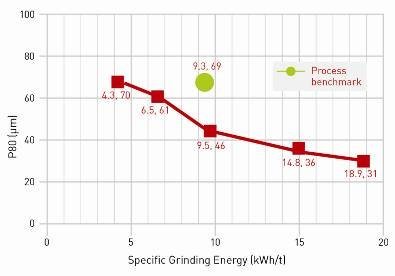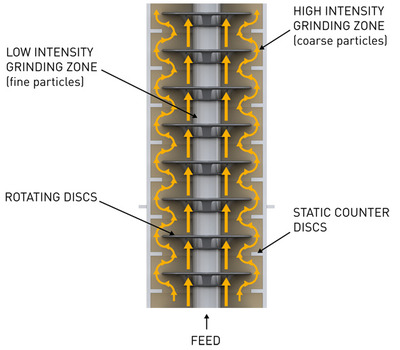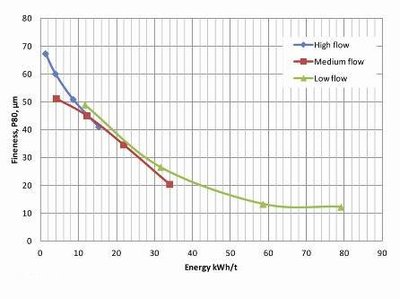High-intensity grinding at its finest
It is a well-recognised fact that global ore grades are declining while commodity demands continue to rise. These ore bodies are increasingly complex, requiring a finer grind size for maximum mineral recovery and grade, and are setting new challenges, particularly for grinding technology. Energy efficiency is a major driving force and another challenge to address.
The High Intensity Grinding (HIG) mill has been designed specifically to manage these types of complex, fine-grained ore bodies that are rapidly becoming more economically viable. While this technology has been utilised and proven for more than 30 years, further development, backed by intensive testwork, has resulted in the HIGmill now being available in the minerals processing industry. The adaptability of the mill means it is suitable for a wide variety of processes and offers other benefits such as minimised energy usage of up to 40-50% compared with traditional ball mills (see Figure 1).

Grinding efficiency
In a typical application, the HIG process begins with the circuit feed being pumped to a scalping cyclone upstream of the mill which ensures a tighter product specification and defines the pulp density. The defined underflow is then mixed with water to optimal grinding density and pumped into the mill at base level. The slurry enters a grinding chamber containing grinding media and rotating discs which provide momentum to stir the charge against a series of static discs.
As the flow transfers upwards, the ore slurry passes through the rotating discs and the free space between the static counter discs lining the wall (see Figure 2). Due to the vertical arrangement of the mill, classification is conducted simultaneously throughout the grinding process with larger particles remaining longer at the periphery, while smaller particles move upwards. The process is typically a single pass with no external classification necessary. With the grinding media evenly distributed, the ore particles remain in constant contact, significantly increasing grinding efficiency.

Energy efficiency
Gravity keeps the media compact during operation, ensuring high-intensity, inter-bead contact and efficient, even-energy transfer throughout the volume. The disc configuration and the whole chamber geometry have been optimised for efficient energy transfer to the bead mass, internal circulation and classification.
Largest industrial units in operation
With installed power up to 5000 kW, the mill is the largest fine grinding unit available to date. This technology comes in various drum diameters and the mill heights can be varied to optimise the media load and power input for specific applications. Chamber volumes range from 400 to 27,500 litres with corresponding drives from 132 to 5000 kW. It is the only ultrafine grinding technology in commercial use that has the capability to use small-size, high-density grinding media in mill sizes above 3000 kW. Over 260 mills have been commissioned and proven in the field.
Online particle size optimisation to maximise process
The HIGmill is able to optimise product fineness online. The energy efficiency remains constant through a wide shaft speed range. Figure 3 depicts three different flow rates with specific grinding energy (SGE) versus product fineness. Each SGE point has been generated by varying the shaft speed.

A feedback control principle is used to measure the particle size distribution by an Outotec PSI online particle analyser and the shaft speed adjusted to maintain constant product size (see Figure 4). In addition to feedback control, feed-forward control could be used to measure scalping cyclone feed quantity and adjust the mill shaft speed to reach target energy per total feed flow.

Compact and simple installation
The benefit of high power intensity and vertical installation is a very small footprint. The head room over the mill is small and the flanged, split shell construction reduces the space needed for maintenance. The top-supported hanging arrangement keeps the floor and sides clear, simplifying maintenance and the emptying of the beads.
Gravity, together with an internal hydroclassifier, prevents the grinding media from escaping the mill by pushing the grinding beads back down into the milling process, letting through only the fine ground slurry.
Adaptability
A wide range of grinding applications can be addressed due to the excellent flexibility the mill has in adapting to fluctuating process conditions.
A typical application for the mill is the regrinding of concentrates (eg, magnetic, flotation). The flows from these types of upstream processes can vary considerably due to fluctuations in ore grade and quality, as can the target fineness due to variations in the ore mineralogy. Flow fluctuations in the mill can be dampened by maintaining the net energy constant via control of the mill shaft speed. Product fineness is also controlled by adjusting the shaft speed and thus power input.
If the conditions permanently change so that the current operational range is no longer optimal, the range can be optimised by changing volumetric media filling, bead size or bead material. Both ceramic and steel beads can be used. In ultrafine grinding the typical bead diameter is 1-3 mm and in coarser grinding 3-6 mm.
Long maintenance intervals
The drum segments and wear components have been specifically designed to make maintenance simple and quick. The casing is flanged vertically so that it can be split down the centre into two halves that can be moved apart on a railing system. After exposing the internals, changing individual discs and liner segments can be performed by two skilled mechanical trade personnel.
Wear of the discs is even around the circumference. The wear is faster in the bottom part of the mill and typically the lowest discs have to be replaced a few times before the total set is changed. For a complete change, a spare shaft ready for installation is an option available. Wear components can be lined with polyurethane, metal hard facing or natural rubber depending on the application.
Summary
This innovative and unique grinding technology provides advanced, energy-efficient fine and ultra-fine grinding - particularly important for today’s more challenging ore bodies. Suitable in either green or brownfield applications with its small footprint and high adaptability to process variations, HIG technology, at up to 5000 kW, delivers the highest installed power to date.
Egg producer improves efficiency with flexible marking system
A Spanish poultry company needed an operator-friendly and reliable marking system to mark 200,000...
Women in automation: Ella Shakeri
On International Women's Day 2024, Swisslog System Design Engineer Ella Shakeri is...
Keeping manufacturing and distribution on track
RFID systems can help revolutionise the way a business tracks goods and manages inventory.








